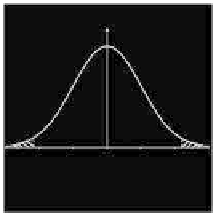Biology Reference
In-Depth Information
Science is the great antidote to the poison of enthusiasm and
superstition.
Adam Smith (1723-1790)
A fundamental question, both philosophically and
biologically, is what causes differences within a species?
The issue is complicated, but commonly the causes are
classified as genetic or environmental or as
developmental ''noise.'' Developmental noise is a random
occurrence unrelated to genetic or environmental causes,
such as the small physical differences between identical
twins when they emerge from the womb. When
considering genetic, environmental, or developmental
factors, one would like to attribute a certain amount of
variation to each factor, but this is usually not possible on
an individual basis. Complicating the problem further,
there will usually be some crossover between factors
(called covariance). For example, a child whose parents are
musicians may be genetically predisposed toward
music (if such musical genes exist), but would also benefit
from being reared in a musically nurturing environment
and engaging in music-related behaviors. Similar
confounds occur in analyzing intelligence levels.
Chapter 4
QUANTITATIVE
GENETICS AND
STATISTICS
Probability Background
Relation of Probability Distributions
to Statistical Testing
In no sense have these questions been thoroughly
answered in this topic, but we shall pursue some
worthwhile inquiries while presenting several statistical
tools useful in many areas of biology.
1
These tools will
enable us to make unbiased judgments on data-based
hypotheses. We shall focus on three related topics:
Statistical Testing
1. How do we decide whether any observed differ-
ences are statistically significant?
2. Is the contribution of an underlying genetic factor
significant relative to environmental factors?
3. What is the common mathematical thread linking all
statistical tests comparing means, evaluating the
contribution of various factors, or testing the linear
dependence of an outcome on a set of predictive
variables?
We begin by reviewing some terminology from
probability.
1. For an in-depth analysis of this field, the reader is referred to
Falconer (1989).
129












